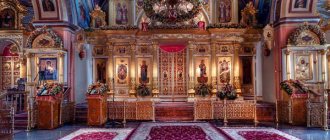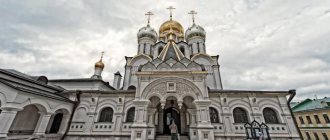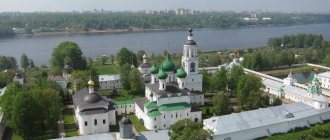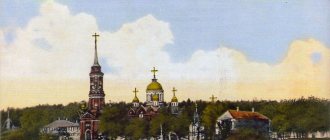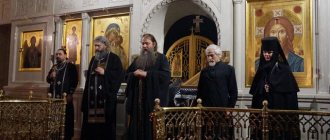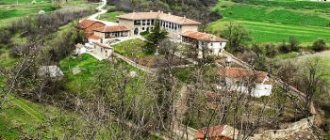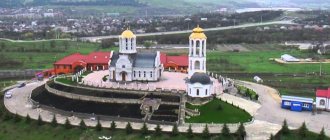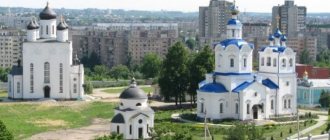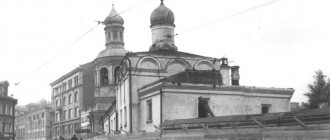"Save me, God!".
Thank you for visiting our website, before you start studying the information, please subscribe to our Orthodox community on Instagram, Lord, Save and Preserve † - https://www.instagram.com/spasi.gospodi/. The community has more than 60,000 subscribers. There are many of us like-minded people and we are growing quickly, we post prayers, sayings of saints, prayer requests, and timely post useful information about holidays and Orthodox events... Subscribe. Guardian Angel to you!
St. Daniel's Monastery is one of the oldest Moscow monasteries. It was founded in the 13th century by Holy Prince Daniel of Moscow. The first temple of the monastery was erected in honor of the venerable founder Daniel the Stylite. Today the Orthodox building has the status of stauropegia. The rector is the Moscow bishop - the Patriarch of Moscow and All Rus'. And the managing viceroy, the archimandrite, is in charge of the daily life of the community.
The monastery has a communal rule, which means common meals, prayers, and work for all the brethren. Anyone can attend the service. They happen daily. You can also come to the excursion service, where you can see the Sunday school, publishing house, church workshops, churches, catechetical courses and icons of the Danilov Monastery.
The best article for you, go to: Raifa Bogoroditsky Monastery
A little history
13th century! How it was…
Having resolved the dispute between his two brothers peacefully, without military action, the grateful Moscow prince in 1282 founded a temple in honor of Daniel the Stylite, whom he revered as his heavenly and omnipotent patron.
According to an ancient legend, Prince Daniel later took monastic vows and bequeathed to be buried, of course, in the monastery he himself founded. Which was, of course, done.
And in 1652 his relics were found incorrupt. With worthy honors, in front of a huge crowd of people, by decree of Tsar Alexei Mikhailovich, they were moved to the Church of the Seven Ecumenical Councils, located here.
Nowadays, not far from the monastery, almost at the exit from the Tulskaya metro station, in a small park, there is a monument to the holy noble prince Daniil of Moscow. Its coordinates: 55.7129, 37.62305.
But let's return to the monastic history.
Oblivion and revival of the monastery
In 1330, Daniel's son transferred the inhabitants of the monastery to the Kremlin, to the princely court. Modern scholars suggest that he did this because he was seriously thinking about making Moscow the capital of the state. For as many as 300 years, a small wooden church and a small village with it were left without proper attention and care. Everything gradually deteriorated and fell into disrepair.
Only in 1650 the abandoned temple was revived by the decision of Tsar Ivan the Terrible. The times were turbulent, and the monastery was always in the center of devastating military events. And in 1812, before Napoleon’s troops entered Moscow, he was, one might say, evacuated. His holy relics and treasury were simply taken out of the city.
When the situation became more or less calm, everything returned to normal. The monastery began to live an ordinary life. Gradually it took on the form that exists to this day.
It is known that from the beginning of the 19th century it housed a shelter for elderly clergy and elderly women and their widows.
Pages of history. This was also
In 1918, the monastery ceased to exist, but only formally. In fact, life went on there. But this did not last long, and in 1929 global changes began. The new government ordered the bell tower of the Danilovsky Monastery to be dismantled and the bells sent for melting.
According to the documents, everything was done that way. But this did not happen in life. American diplomat Charles Crane miraculously managed to take them to Harvard University, where they remained until 2007. The first bell to be returned to its homeland was called “Everyday”.
Even the dead were uneasy at that time. The monastery cemetery that existed there was devastated and then completely destroyed. Particularly famous people: Gogol, Yazykov and some others were reburied at the Novodevichy cemetery.
In 1930, on the holy land of the monastery there was an isolation ward for children, so-called enemies of the people. Mostly these were children of people shot at the Butovo training ground by the NKVD. Alexy-2, the Patriarch of Moscow and All Rus', called this terrible training ground “Russian Golgotha.” More than 20,000 people were shot there.
And their children were collected in an orphanage on the territory of the Holy Trinity Danilov Monastery. Naturally, there could be no talk of any normal conditions. Children there got sick and died. A place with numerous children's remains was discovered near one of the monastery walls.
In memory of everyone buried on the lands of the St. Danilov Monastery throughout its history, a memorial chapel was erected here.
Since 1983, the monastery complex on Tula began to be revived. Now it bears the proud name “stauropygial”, that is, the Abbot of the Danilovsky Monastery is only the ruling bishop of Moscow himself (Patriarch of All Rus'). In addition, the Department for External Church Relations and the building where meetings of the Holy Synod are held are located on its territory.
In 2007, a white stone crypt was accidentally discovered under one of the galleries of the Church of the Holy Fathers of the Seven Ecumenical Councils. It is believed that Archbishop Nikephoros Theotokis, a Greek enlightener, was once buried there. Not far from this place there is now a memorial cross made of white marble.
In the basement of the hospital building, at the moment, there is a temple of Seraphim of Sarov. In the building of the Patriarch's residence there is a church in the name of All Saints who asked for the Russian land.
Prince Daniil
Prince Daniel was born in Vladimir-on-Klyazma in 1261. In 1272, by lot, the Moscow principality, which was poor at that time, became his inheritance. During his reign, he established himself as a meek and peace-loving statesman. Prince Daniil took part in the war only once, defeating a Tatar detachment in the vicinity of Pereslavl in Ryazan, sent by Prince Konstantin to annex the Moscow lands. Having won, he, contrary to all expectations, did not capture Ryazan. Prince Vladimir, who was taken prisoner, was kept in very good conditions until reconciliation. Daniel's wisdom and mercy were noticed, and he became highly respected by the other princes and the common people.
In 1269 he became the Grand Duke of All Rus'. Prince Daniel reigned for about 30 years. By the way, it was he who laid the foundation for the unification of Rus', which was fragmented at that time, around a single capital - Moscow. The prince died at the age of 42 and was buried in the Danilovsky monastery he founded.
Territory of the Danilov Monastery
Bells. From big to small
Currently, the bell tower with the temple of St. Simeon the Stylite located there has been restored. Its bells deserve a special story.
The bell ensemble of the Danilov Monastery was created over more than 200 years, and today it consists of 18 bells of various sizes and tones.
The dominant bell here, the “Big” bell, weighs almost 12 tons! It was ordered by the merchant Zakharova with her own money, in memory of her husband. The second bell, “Polyeleos”, weighs about 6 tons. Another “Everyday” bell weighs 2 and a half tons.
Next come 10 ringing bells, smaller ones weighing from 30 to 500 kilograms. One of them was cast in 1682. It was donated to the monastery by Tsar Theodore Alekseevich.
The next 4 ringing bells are even smaller, they weigh from 10 to 16 kilograms. It turns out that 17 bells are involved in creating the bell melody. The “guard” bell always sounds separately from others. With its weight of 2300 kg, it creates its own, unique sound. Which is not always possible with such large bells.
Most of these ringing rarities were cast at the Moscow Finlyandsky factory at the turn of the 19th and 20th centuries. And to this day, their chimes and the melodies they create delight even music connoisseurs.
Temples and chapels of the monastery
In 1988, another chapel was erected in the center of the monastery courtyard. Its appearance is dedicated to a significant event: the 1000th anniversary of the Baptism of Rus'.
Once upon a time there was a monument to V.I. Lenin. It was decided to move it to another place, but when the sculpture was moved with the help of a crane, something went wrong and the monument was broken. Now a delightful over-the-hill chapel has been built here.
The most ancient temple of the Holy Fathers of the Seven Ecumenical Councils, originally built back in 1555. It was consecrated in the royal presence of Ivan the Terrible.
In the 17th century, the Intercession Cathedral with a chapel was erected next to the temple.
Over time, the old temple was dismantled, and the new one became the second tier above the Church of the Intercession of the Danilovsky Monastery. Much later, in the next century, two more chapels were added to this upper temple. In one of them, the northern one, the relics of the blessed prince Daniel are now kept.
In the third tier of the temple, in the 18th century, another church was built in the name of St. Daniel the Stylite. The result is a rather complex structure, in which one building combines several different churches.
Trinity Cathedral is the largest on the ground of the Danilov Monastery in Moscow.
It was erected in 1833-1838, it was designed by O.I. Bove. It is surrounded on 3 sides by columns.
The central altar is consecrated in honor of the Holy Trinity. There are two more: in honor of the conception of Righteous Anna and St. Alexy, man of God.
Now in the Trinity Cathedral there are such miraculous icons as the icon of the Mother of God “Three-Handed” and the icon of St. John Cassian the Roman.
In the territory
The Danilovskaya monastery is surrounded by powerful fortress walls.
In the evenings they are illuminated very beautifully, and their snow-white turrets with loopholes do not look threatening at all.
Inside, within the walls of the former fortress, there are also passages along the fortress walls. But they are closed to visitors. It's a pity. For example, in the Rostov Kremlin we had great fun wandering around the ancient walls.
The monastery territory is not very large. And despite the fact that there are quite a lot of stone buildings and temples here, you feel some kind of spaciousness.
There are neat paths around, beautiful lanterns installed, and there are many benches.
This all somehow makes me very conducive to stopping, being in this moment of life, remembering myself and God, and calmly reflecting on my life.
Restoration of the monastery
In 1983, the Danilovsky Monastery was the first to be returned to believers. By 1988, on the millennium of the baptism of Rus', the almost completely destroyed monastery was restored and restored. The complex was returned to the appearance it had in the 17th-19th centuries.
Today the monastery takes an active part in the life of society. For example, the monastery even has its own website. The Danilovsky Monastery in Moscow is considered the spiritual center of the Russian Orthodox Church. The residence of His Holiness the Patriarch is located here. His deputy at the moment is Archimandrite Alexey. Under his leadership, a huge amount of the most diverse Orthodox literature is published in the monastery. For example, it is here that the “Danilovsky Evangelist” series, known to all believers, is published, which contains biographies of Orthodox ascetics of the 20th century.
Revered Saints and Shrines
Life of Saint Spyridon of Trimythous
Numerous shrines are kept with great honor and respect within the walls of the Danilov Monastery. In 2007, another unique relic appeared there: in the glass icon case of the Intercession Church of the Danilovsky Monastery, at the top there is an icon of Spyridon of Trimifuntsky, and below is his shoe.
At first glance, the shoe looks like new, but if you look closely, you can see scuffs on it.
Spiridon lived more than one and a half thousand years ago, but despite this, many facts from his life are known. His family was far from poor, and after the death of his parents, Spiridon inherited a lot of money and land. Over time, he became the bishop of the Cypriot city of Trimifunta.
Countrymen were not afraid to turn to the rich but kind Spiridon; they often borrowed money from him. “When you can, then you’ll give it back,” Spyridon always said. But then grief happened in his family: his wife, whom he loved very much, died. Having distributed everything to the poor and leaving himself only a staff and clothes, Spiridon began the life of a wanderer.
Miracles of the Cypriot Saint
He performed many miracles in the places he visited. They say that one day his mother brought the body of her recently drowned daughter to him. Seeing the woman’s grief and tears, Spiridon was able to revive the girl. From the surge of feelings and such shock, the mother died immediately. Spiridon had to resurrect her too.
This is just one of thousands of stories of the saint helping people. This is evidenced by the stories of parishioners of the Intercession Church in our time. So, two women owed a large amount. Returning home after praying to Saint Spyridon, they unexpectedly found an envelope on the ground with a large sum of money.
During his lifetime, the saint performed many miracles, but it is also incredible that miracles continue after earthly life. His body, stored on the island of Corfu, is still incorruptible and, moreover, maintains a constant, normal temperature for a person!
According to existing legend, he still “walks” the earth and helps those in need. This amazing fact is confirmed by his shoes, which miraculously wear out to such an extent that they have to be replaced. And worn-out shoes are donated to all churches and monasteries around the world! Such miracles!
Spiridon Trimifuntsky helps in financial matters
Spyridon of Trimifuntsky helps mainly in financial matters, in everything related to money. Therefore, here you can often find various celebrities surrounded by people in black (security), and cool businessmen who even here do not part with their mobile phones (even though this is prohibited here). Yes, even just according to the rules of decency, it is recommended to turn off phones in the temple.
But, nevertheless, everyone stands at the glass box with the holy velvet slipper and quietly prays, each for his own. Maybe he will help the rich man open another dollar account with many zeros. But if someone really needs help, then by turning to Spyridon of Trimifuntsky, he will definitely receive it.
Saint Spyridon also helps people on long journeys and travelers. So, now we will turn to him too!
Danilovsky Monastery in Moscow. Shrines
The most important shrine of the monastery is the miraculous relics of Prince Daniel, its founder. It was thanks to them that the restoration of the monastery began during the reign of Ivan the Terrible. After the transfer of the monks to the Spassky Monastery, only a small church and a cemetery remained in Danilovsky. However, at the grave of Prince Daniel, various kinds of miracles and healings of the sick began to occur. Most likely, this is what served as the impetus for the restoration of the monastery. The prince was canonized in the 17th century. It was then that his relics were discovered. After 1930, they were kept in the Church of the Resurrection of the Word, located near the Danilovsky Monastery. Then they disappeared without a trace. In 1986, the Metropolitan of Washington donated the first particle of the relics to the monastery. Today, several parts are stored here, placed in icons, a shrine and an ark.
The Icon of the Matrona of Moscow is another shrine located at the Danilovsky Monastery in Moscow. During her lifetime, Matrona was a deeply religious person. She was born completely blind. There was a bony bulge in the shape of a cross on her body. From the age of seven she discovered the gift of healing the sick. She died on May 2, 1952. For a long time, her grave at the Danilovsky cemetery was desolate. Later, miraculous healings began to occur here. The relics of the saint were discovered in 1998. Nowadays they are kept in the Intercession Convent.
The Danilovsky Monastery in Moscow is the owner of other shrines. The most interesting are:
- Ark with the relics of St. Nicholas the Wonderworker.
- Ark with the relics of Alexander Nevsky.
- Shoe of Spiridon of Trimifuntsky.
- Icon of Sergei of Radonezh.
- Icon of Seraphim of Sarov.
How does the monastery live today?
Modern rich monastic life
The monastery Patriarchal male choir has been famous for many years. It consists of 16 talented singers. Taking part in Sunday and all holiday services, often going on tours in different cities, the choir of the Danilov Monastery gained fame far beyond the borders of its monastery.
The brethren of the Danilov Monastery perform charitable and merciful deeds in medical and children's institutions, conduct lessons in schools and other educational institutions.
The monastery has its own publishing house, online store, there is a Sunday school, various workshops, for example, icon painting. There is also a “Helpline” here.
Social service
For people suffering from alcohol and other addictions, a help center called “Metanoia” has been specially created in the monastery. The unique program “Orthodox Internet Course” (PIC) for distance learning for people who want to learn more about Orthodoxy, strengthen their faith in God, and answer their pressing questions was created by employees of the Patriarchal Center for the Spiritual Development of Children and Youth of the St. Daniel Monastery.
There is also a volunteer service here. Since volunteers often visit children's schools, hospitals, and boarding schools, it is very important for them to know and be able to apply the basic rules of communication with children. And when communication takes place interspersed with games, getting to know each other and spending time together becomes more interesting and useful for everyone. All this, and not only this, is taught in the “Game Modeling Workshop” at the Danilov Monastery.
By calling by phone, you can find out more about all this, as well as find out the schedule of services, how to submit the prayers correctly, the opening hours of the monastery, its opening hours for visitors and all the information that interests you.
Guests are welcome here!
The monastery is guarded 24/7 by Cossacks. You are not allowed to take photographs in temples here; this is a strict rule here. There is also a church and monastery shop where you can purchase useful religious literature and other important attributes. There is also a parking lot and a hotel with cozy rooms nearby (I’ll tell you more about it later in this article).
In the store located right there, you can buy and try your own products produced at the local bakery: very fresh and tasty pastries! You can also buy dairy products brought from more distant monasteries.
In general, before entering you can find a lot of interesting and useful things.
At the entrance to the monastery territory there is a special locker with women's scarves and skirts. A woman's lack of a headscarf or a very short dress are not welcome here. However, as in all church institutions.
The Moscow St. Daniel's Stavropegic Monastery stores a lot of wonderful and beautiful things, so majestic that emotions simply overwhelm! Come and see for yourself!
Where to stay
If you want to attend services, work in the monastery, or just stay in this wonderful place for a few days, you can use the services of the Danilovskaya Hotel, which is located in close proximity to the Orthodox monastery.
Quite a modern hotel building. But it is very unusual that both on the street and inside there are icons and paintings with biblical and evangelical scenes everywhere.
The rooms are quite simple,
and inside there are all the necessary amenities: a bed, bedside tables, table, refrigerator, TV.
But the most important advantage of the Danilovskaya Hotel is the amazing view from the window of the St. Daniel Monastery
and the Church of the Resurrection, standing separately. This temple is better known as the Temple of the Resurrection of the Word in Danilovskaya Sloboda.
How wonderful it is to wake up in the morning to the wonderful sound of bells! True, some hotel residents considered this event to be the main drawback. Everyone is different, so decide for yourself whether you like the chime alarm clock or not.

